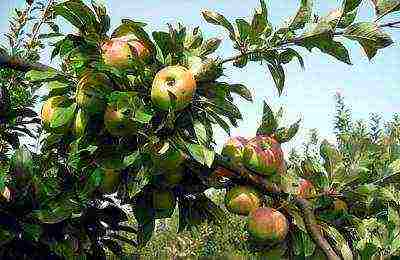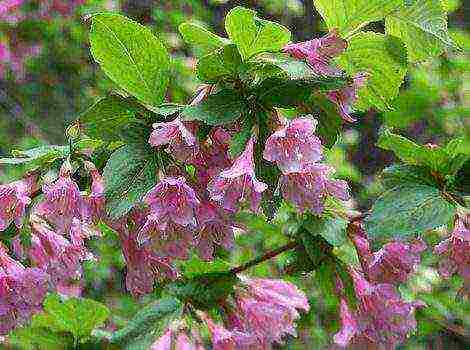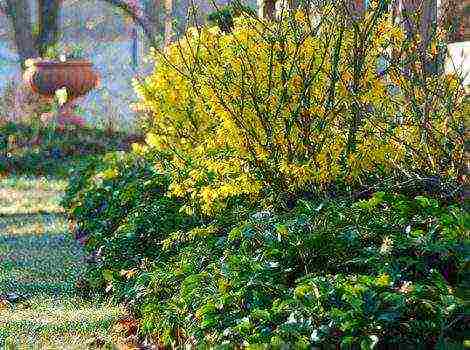Content [show]
Description of raspberry penguin
Raspberries of the Penguin variety were bred by breeders in 2006. It is a remontant early maturing plant, resistant to various diseases and fungi. A distinctive feature of this variety is its high productivity. From one bush per season, you can get up to 6 kilograms of large, sweet berries.
Raspberry Penguin belongs to the standard type of bushes, the height of which can reach 1.5 meters. It has elastic and strong stems, with shortened internodes. Bushes do not need support. The shoots of the first year are covered with thorns, which become much less by the second year. A small number of growing shoots simplifies care, but this makes it difficult for raspberry Penguin to reproduce.
By the end of ripening, the fruits have a rich crimson color and a rounded cone shape. Their flesh is dense with a sweet and sour taste and a small bone inside. Taste qualities vary from the growing conditions of the bush. Growing raspberries in sandy soil gives the berry a more sour taste. Average berry weight is from 4 to 5 grams. The berries hold well on the branch for several days, do not crumble. Once harvested, they keep perfectly fresh and frozen.
This early ripe variety can give the first harvest by the end of spring, and the last one at the beginning of August. The Penguin produces a large harvest every year. Due to the strong development of the root system, the remontant raspberry Penguin can regrow in the same place for a long amount of time.
Raspberry shoots Penguin are frost-resistant and can withstand temperatures as low as -25 degrees. Winter hardiness is a very valuable quality for central Russia.
This type of raspberry is an excellent solution for hobby gardeners. Large berries, double harvest, frost and disease resistance will delight lovers of this sweet berry. The popularity of raspberries adds to the receipt of a rich harvest with minimal maintenance.
Landing
Raspberries are propagated by cuttings. It is better to cut them in sunless weather, with an approximate length of 10-15 cm, with a small number of leaves. Then put the cuttings in water mixed with growth stimulants for half a day. After that, they must be planted in pots with soil.When the cuttings take root, transfer them to a deeper container. They are gradually adapted to the external environment, after which they are planted in open ground.
Great importance for the choice of the place of growth of raspberries should be given to its predecessors. You cannot plant raspberry bushes in places where nightshade crops grew in the year preceding planting, as they deplete the soil.
Correct planting of bushes promotes the growth of a good harvest. In early spring, it is necessary to dig holes of about 50x40x40 cm. Raspberry bushes should be planted 70 centimeters apart, and at a distance of 2 meters between the rows. The removed top layer must be mixed with top dressing and half filled into the hole. Then it is necessary to lower the Penguin raspberry bush into the ground, so that the short-cut annual shoot is located below the surface. Spread the root system evenly, and fill the hole with the remaining earth. The hole with the seedling must be watered. Depending on weather conditions, one bush requires 3 to 5 liters of water. Cover the surface around the bush with mulch (sawdust, straw or hay).
If planting is carried out in the fall, then it is necessary to prepare for it in the middle of summer. To do this, a layer of mail is dug up, weeds are cleaned and fertilizers are added. Adding 2-3 buckets of manure per 1 square meter, 300 grams of superphosphate, 150 grams of sulfuric potassium will not fertilize the soil for 4 years. The right time for planting seedlings in autumn is the third decade of September or the first decade of October.
Despite the possibility of autumn planting, priority should be given to the spring planting of seedlings. The plants will get stronger during the growing season, take root, which will allow them to survive the winter with the least loss of shoots. In addition, the seedlings planted in spring will be able to give a full harvest throughout the season.
Penguin raspberry care
Penguin raspberries grow on almost all types of soil, but they yield richer crops on loosened soil. Planting raspberries on the southern, well-lit side contributes to the early emergence of shoots. Even the slightest presence of a shadow can postpone the beginning of berry formation for a long time ahead.
From ordinary raspberries, remontant is distinguished by the early formation of the ovary of berries, therefore, soil fertility should be given great importance. Raspberries need to be watered in dry times, cultivated from weeds and fed with micro and macro elements. An important macronutrient for the full development of the bush is nitrogen, the lack of which must be replenished with the help of fertilizers.
In the spring, it is necessary to remove frozen and damaged shoots from the bush to form large berries. Sprinkle the area around the bush with mulch. There should be 10 - 15 shoots per 1 running meter of raspberries. Cut the rest. Early removal of snow from the bushes will bring the beginning of the growing season closer.
In autumn, the mulch must be removed, the soil must be dug up to a depth of about 10 cm, fertilized. Nitrogen fertilizers provoke a strong growth of new shoots, so they should not be applied in the fall. You can fertilize the earth with preparations of potassium and phosphorus (60 grams of superphosphate and 40 grams of potassium salt). Such feeding will lead to an increase in the yield next summer.
Reviews
Alexey A: The variety gives a good harvest early enough. In the first year after spring planting, the first berries appeared in early June. At the same time, the berries were sweet and large, with small seeds, easily separated from the stalk. Remained on the branch for up to 5 days in its original state.
Ruslan M: The Penguin raspberry overwintered well during the winter. Tears off branches easily. It turned out to be resistant to diseases and microorganisms. Bushes, low, straight, they can be used in decorative quality. The variety does not need special care. I was very pleased with the abundance of the harvest with little time and physical costs.
Video
Did you like the article? Share on the social network!
Raspberries are rightfully considered a delicious and healthy garden plant. Therefore, it is present on the personal plots of many summer residents. In ordinary raspberry varieties, the appearance of fruits on young shoots occurs only in the second year.... Compared to other garden shrubs or trees, this is fast, but breeders were able to speed up this process even more, for example, varieties of remontant raspberries, the cultivation of which can be found below.
Features of varieties of remontant raspberries: timing of flowering and fruiting
The remontant raspberry includes many varieties bred by the breeding method, the shoots of which bear fruit already in the first year. Its content allows you to get more harvest than from conventional or wild varieties. Why?
Repaired raspberries at the beginning of spring start up shoots from the root, which develop rapidly and in the same season give an abundant amount of fruit... After they ripen, the upper part of the branch dries up, and the lower one becomes woody. In the next season, these last year's bushes give fresh shoots and bring a new crop.
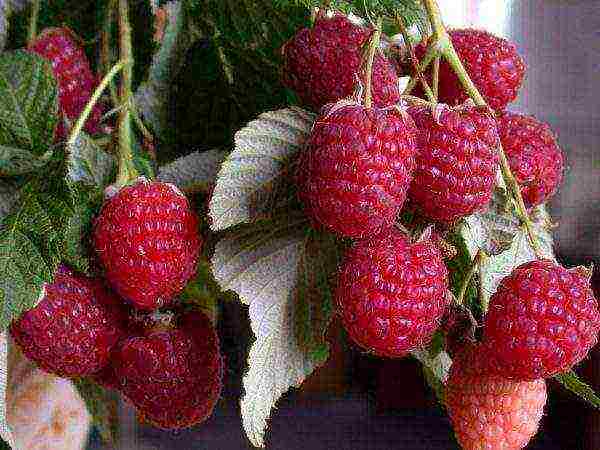 Repair raspberry
Repair raspberry
The peculiarity of these varieties is that the ripening period of fruits on young shoots and old branches is different... This allows you to harvest for a sufficiently long time. It is characteristic that pests rarely live on this raspberry, since it has matured more quickly, and by this time the parasites have not yet had time to multiply.
Two crops are harvested in one season, but in order for this to work, proper care is needed, namely, to pick the first fruits in time so that they do not exhaust the bush... Despite these benefits, remontant raspberries do not reproduce as fast as regular raspberries. I would like to note for novice gardeners, if you grow several bushes on your site, it will take years for them to grow naturally into a large plantation. Although this can be useful, because inconveniences are eliminated when the shoots spread outside the area allocated for them.
The most popular varieties of remontant raspberries are:
- penguin;
- Golden autumn;
- hercules;
- rhinoceros;
- polana;
- ruby necklace, etc.
Landing rules on a personal plot, soil preparation
For high yields, you need to provide the raspberries with plenty of sunlight. therefore the planting site should be in an open area away from trees and buildingsthat create a permanent shadow. For remontant varieties, watering is important, so you need to choose a place where it is convenient to deliver water. Direct planting can be carried out both in spring and autumn.
It is believed that a more plentiful harvest in the first year is obtained with the autumn planting of bushes. This should be done in late September and early October, before the start of the morning frost.
You can plant raspberries in the immediate vicinity of water bodies, but the groundwater should be deeper than 1 m from the surface. The best soil is loam, although the bushes can grow in almost any land, especially if they are provided with the necessary amount of fertilizer. It is good when mustard or rye grew on the site in front of the raspberries. If the predecessors were potatoes, peppers or tomatoes, then fertilizer must be added when planting.
To facilitate the preparation of the site, fertilization can be carried out not in the planting pits, but simply around the entire perimeter. To do this, for each square meter of area, you need to add 2 buckets of humus and a glass of superphosphate and potassium sulfate. After that, the soil is dug up or processed by mechanized methods.
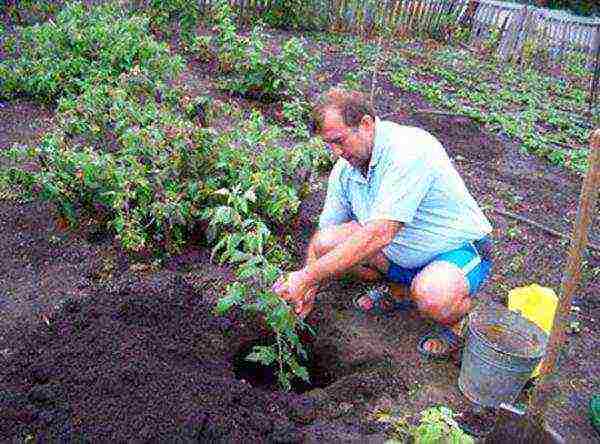 Planting raspberries can be done in pits or trenches
Planting raspberries can be done in pits or trenches
When the place is prepared, you need to dig holes along the root collar of the seedling. The distance between the bushes should be 50-100 cm, and between the rows 120 cm... Each plant must be watered with water in the amount of 5 liters. When the liquid is completely absorbed into the soil, then the earth can be mulched.If the planting takes place in the spring, then it will be useful to soak the roots of the seedlings for a day in water with a growth stimulator, which will serve as an additional guarantee of high survival rate.
Proper summer care: watering, feeding and harvesting
Since remontant raspberries are actively bearing fruit, they are in dire need of moisture. For this in the summer it should be watered periodically... This should be done once a week. The soil under the bushes should always be moist. In dry times, the frequency of watering can be increased. Unlike other plants, which require moisture only for a short time during the period of fruit formation, raspberries need it constantly. This is due to its peculiarity of ripening two crops per season. With proper watering, the second harvest will be only slightly worse than the first.
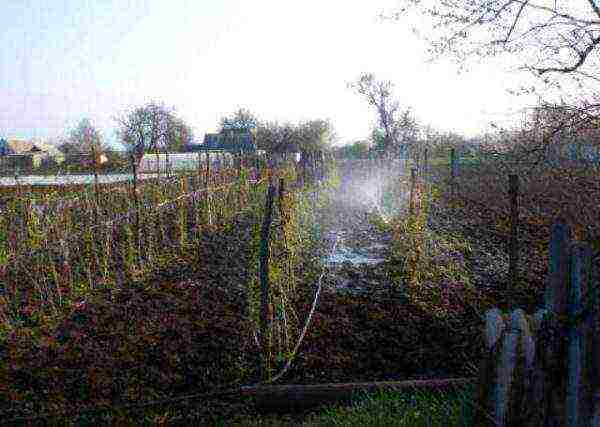 Raspberries need constant watering
Raspberries need constant watering
The soil surface should be loosened and weeds removed. In the first year after planting, many seeds of wild plants are kept on the site, which will compete with raspberries. They need to be weeded periodically, preventing overgrowth. With proper care several seasons, raspberries will grow and fill all the space between the rows. Then the care will become a little easier, since she herself will not allow the development of weeds.
If the variety chosen for planting has high growth and thin branches, then it will sag under the weight of the fruit. To avoid this, you can dig in or hammer in rows with raspberry poles or poles at a distance of 2-3 m from each other... Between them, at several levels, a rope, wire or twine is pulled. The bottom support should be 50 cm from the ground, and the next 50 cm higher.
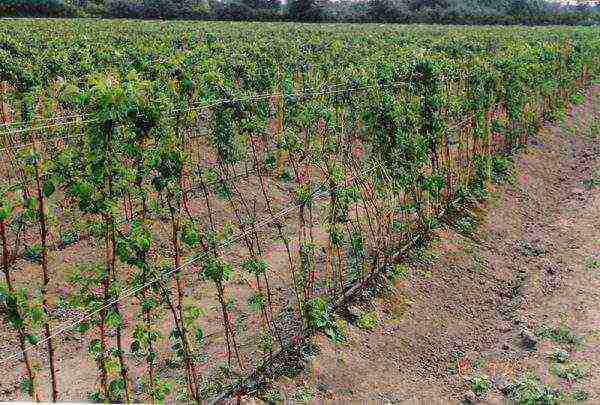 It is recommended to tie up raspberry bushes to avoid damage to the berries.
It is recommended to tie up raspberry bushes to avoid damage to the berries.
In this way, it will be possible to tie up several bushes between each pair of pillars. If this is not done, then during fruiting the branches will fall on the ground and the fruits will start to deteriorate... This will be inevitable, because the distance between the bushes, until the raspberries have grown, is very large and they do not hold each other.
From the third season, the soil in the area with raspberries becomes poorer, therefore, it needs additional feeding. This is best done with organic fertilizers. To do this, you can dilute chicken droppings at the rate of 1 kg per 20 liters of water. Liquid fertilizer is applied at 4 liters per sq. m. Such recharge is necessary 2-3 times per season.
How to prune bushes in spring and autumn?
Pruning can be done twice a year. The first time in the spring, before flowering, and the second in late autumn. This is done according to the following scheme. It is recommended to cut the bushes at a distance of 3 cm from the ground in late autumn... The resulting tops should be burned. This approach eliminates pests that are preparing to winter on the branches, and will give an impetus for the rapid development of young shoots in the spring.
In the fall, you can cut remontant raspberries as usual varieties, when only the tops of the bushes are removed. This will allow you to get young shoots and two-year-old shoots for the next season, which will stretch the ripening of the fruits.
Spring pruning consists of removing dry parts of the bushes that have not survived the winters.at. This sanitary pruning is done before the first healthy kidney. It is easiest to carry out it in April, when the plant begins to actively resume its vital activity. Then you can immediately see which kidneys are healthy and which ones have dried up. Sanitary pruning at this time does not take much time, but you need not delay with the beginning, because if you start work when the first leaves appear, you can damage them.
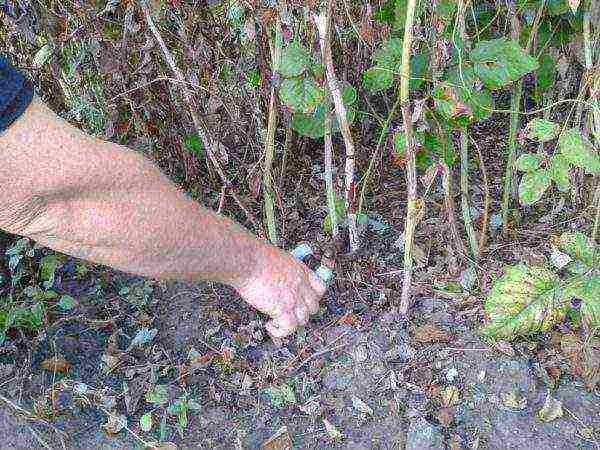 Autumn raspberry pruning
Autumn raspberry pruning
Planting density is controlled in spring... It is necessary to remove excess shoots in such a way that 1 sq. m there were 10-15 of them left. If this is not done, then the plants will compete with each other, and their fruits will become small and less sweet. If in the fall all the bushes were cut to the root, then in the spring there will only be a little thinning of the young shoots if there are too many of them.
Breeding methods, advice for novice gardeners
There are several ways to propagate remontant raspberries:
- plant root suckers;
- root cuttings;
- green cuttings.
Root offspring
Breeding bushes from root suckers is not possible on all varieties, since some of them have a weak underground part. The method is to dig out the root shoots that appear in the bushes at the age of several years.... One plant can produce around itself several offspring, the number of which ranges from a few pieces to two dozen.
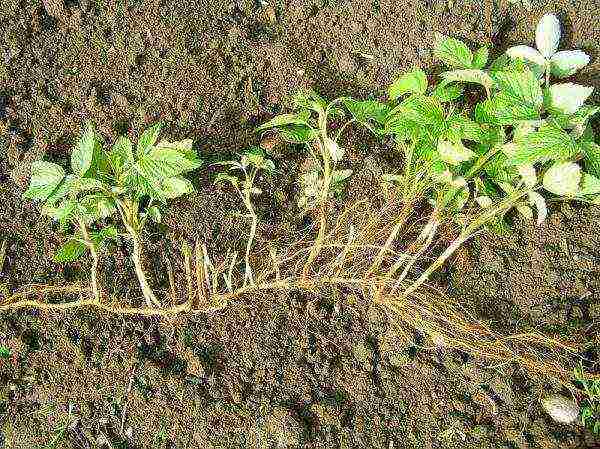 Reproduction of raspberries by root suckers
Reproduction of raspberries by root suckers
The shoots grow next to the mother bush, so they will soon compete with it, but if they are dug up and planted in a new place, then you can get more benefit. For this, when they reach 5-10 cm, they can be dug up and planted. After they take root, they will begin to grow rapidly and bring the first harvest the next season.
Root cuttings
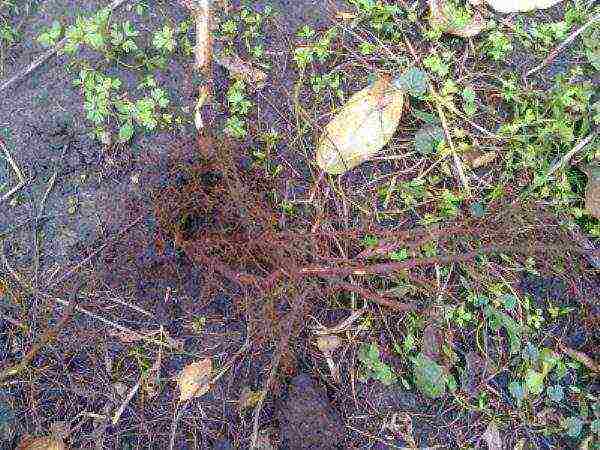 Propagation of raspberries by root cuttings
Propagation of raspberries by root cuttings
Propagation by root cuttings is that in the fall, the root of a healthy plant is dug up and divided into pieces of 2-4 cm... The resulting cuttings are planted in one row to a depth of 6-8 cm and watered. In the spring they will sprout, which will need to be watered until autumn. At the end of August, they will turn into full-fledged seedlings, and they can be transplanted to a permanent place.
Conventional cuttings
Breeding with green cuttings is also an effective way. It lies in the fact that at the beginning of summer, young shoots are separated from the mother bush with a small root... To do this, it is enough to go deep a few centimeters into the ground and cut off the branch. After that, it is planted in the ground and actively watered. For maximum effectiveness, cut green shoots can be soaked in a growth promoter. In addition, if they are planted in a greenhouse, the survival rate will also increase.
 Breeding raspberries with green cuttings
Breeding raspberries with green cuttings
Thus, it is safe to say that to breed and care for remontant raspberries, it is quite simple... Most of the time and effort will have to be applied in the first year, but when the root system gains strength, then worries decrease. The pruning process also does not require special skills, and if you completely cut off the bushes in the fall, then in early spring you can practically not devote time to the plants.
The repairing raspberry variety Penguin is often grown in home gardens. Popularity is ensured by sweet berries and unpretentiousness to growing conditions. The variety is valued among gardeners and consumers for its attractive appearance. Raspberry Penguin is often used as an ornamental plant to decorate gardens.
Description and distinctive features of the remontant raspberry Penguin
Raspberry Penguin is a highly productive and early maturing remontant variety, which is characterized by good immunity to pests and diseases.
Repaired raspberries differ from ordinary fruiting. Berries are tied on one-year and two-year shoots. Thus, the Penguin raspberry gives two harvests: in early summer and early autumn.
The variety got its name for the standard type of bush.Erect shoots, medium growth rate, height - up to 1.4 m. Strong stems, shortened internodes. The foliage is dense, the leaf blade is of a rich green color, of medium size.
Penguin is one of the earliest ripening varieties of raspberries
The fruits are large, round-conical, dark red in color. The mass of one berry is 4-6 g. Drupes are small, even. The berries are sweet, with a slight sourness, easily separated from the stalk. The fruits are elastic, dense, therefore they tolerate transportation well and retain an attractive appearance for a long time.
When ripe, the berries acquire a dark red color.
Variety video
Advantages and disadvantages of the Penguin - table
Landing features
In order for the remontant raspberry Penguin to actively grow and develop, to bring abundant harvests of berries every year, certain planting rules should be adhered to.
Dates and place of landing
Raspberry bushes Penguin are planted in spring or early autumn. In the autumn, it is necessary to plant shoots in a warm season, so that the bush has time to take root before frost.
Raspberries grow well and give stable yields when grown in sunny areas without constant northerly winds. Suitable soil - fertile chernozem, loam, sandy loam with neutral acidity. A place for raspberries is chosen on small hills with high-quality drainage and air permeability. Do not plant raspberries in the lowlands. Groundwater should be no higher than 1.2 m.
Selection of seedlings
Raspberry seedlings are recommended to be purchased in garden shops and nurseries. The root system of the plant should consist of many fresh roots. There should be no dry roots.
The main attention should be paid to the buds at the base of the shoots (the minimum number is 3 pieces).
The smaller the seedling, the more viable it is
Site preparation
The preliminary preparation of the site for the raspberry tree is to saturate the soil with nutrients. When disembarking in the spring, it is carried out in the fall or a month before planting.
On the site, half-rotted manure, humus or compost are evenly scattered with a layer of 5–7 cm. 55 g of superphosphate and 35 g of potassium salt are added per 1 m². Dig it to a depth of at least 30 cm.
Step by step process
When planting a raspberry seedling, the roots must be well straightened - this will exclude their bending
When planting several bushes, it is necessary to observe the distance between the bushes of 0.7-0.8 m, between the rows - 1 m. Raspberries can be planted using the dimple and tape method.
- In the prepared place, dig a recess with a diameter of 40 cm and a depth of 50 cm.
- The seedling is placed in a hole at an angle of 45 degrees.
- Carefully cover the plant with earth, slightly tamping it.
- The pit is completely covered with soil.
- The seedling is cut, leaving no more than 6 cm above the ground.
- Make a hole, water the plant with 20 liters of water.
- The hole is covered with mulch - earth, sawdust or shavings, peat.
Planting remontant raspberries - video
Plant care
Caring for the plant affects the quality of the fruit and the general condition of the raspberry tree. Raspberries have a tendency to overgrowth, and therefore need constant thinning. Particular attention should be paid to the cleanliness of the hole under the bush. It must be regularly mulched, weeded and loosened.
Watering
Adequate moisture contributes to high productivity of raspberries. It does not tolerate drought well and needs systematic watering.
In temperate climates, raspberries are watered several times per season:
- during the flowering period;
- during the formation of fruits;
- after harvest.
Also carry out autumn (sub-winter) watering.
The soil is moistened 30–40 cm deep. It is impossible to overmoisten the site. This can provoke the development of diseases. A drip irrigation system works best for irrigating raspberries.
Pruning
When growing raspberries Penguin for two harvests in the fall, after picking the berries, all the fruit-bearing shoots are cut out at the root. Only one-year strong shoots are left. Young shoots can be cut 7-10 cm.
If one autumn harvest is planned, after picking the berries, the bushes are completely cut out to ground level, without leaving hemp.
At the end of the season, all branches of the remontant raspberry are cut to the root.
In the spring (in April), sanitary pruning is carried out. Damaged and frostbitten branches are cut out on the first healthy bud. Such pruning is carried out to increase the yield and improve the palatability of the fruit.
Secrets of competent cropping - video
Top dressing
Raspberry Penguin is quite demanding on the nutrient composition of the soil and needs periodic feeding with mineral and organic substances.
Fertilization schedule - table
Garter
Repaired raspberry Penguin is a high-yielding variety. If the shoots are not tied up, they can sag and break under the weight of the berries. So that the branches do not bend, and the crop does not crumble to the ground, raspberry bushes are tied to trellises. They can be T-shaped and V-shaped.
Wooden or metal posts are dug in along the row of raspberries and the wire is pulled. As the shoots grow back, they are tied to an established support.
If raspberries are grown for two crops, the bush is divided into two trellis planes. On one side, fruit-bearing shoots of two years of age are tied, on the other - young annual shoots.
Trellis makes it much easier to care for plants and harvest.
Shelter for the winter
With the complete pruning of shoots for the winter, you just need to cover the plant with mulch: peat, humus or wood chips.
If raspberries are cut for two crops, young shoots are bent to the ground and covered. To do this, a wire is pulled along the bush at a level of 30–35 cm from the ground and shoots are tied to it. From above, the bushes are covered with special material, thick paper, plywood or roofing felt.
Preparing raspberries for winter should begin in the fall, before freezing temperatures.
If the winters in the region are snowy, the bush must be covered with snow with a layer of at least 0.5 m. During the season, it is recommended to constantly add snow and make sure that an ice crust does not form.
Diseases and pests of raspberries
The Penguin remontant raspberry variety is resistant to common diseases and pests. Only weakened plants are susceptible to diseases, therefore the main prevention is full adherence to agricultural technology.
Raspberry pests and control measures - table
Harmful insects in the photo
Raspberry diseases and methods of their treatment - table
Diseases of the remontant raspberry in the photo
Harvesting and storage
The first crop is harvested in early June. The second ripening of berries is observed in early August. The average productivity of one bush is 5 kg per season.
Fresh berries are stored for 5–7 days in a refrigerator at a temperature of + 2… + 4 ° C and high humidity. For long-term storage, raspberries are frozen or dried.
The Penguin's berries are quite dense, easily separated from the fruit
Fruit of the remontant raspberry Penguin of universal purpose. Fresh and frozen berries are used to make jam, jam, confiture. Fillings for confectionery are prepared from raspberries, added to dairy dishes. Fresh berries are used as an independent dessert or added to fruit salad.
Gardeners reviews
I definitely like the penguin. You can look at it for a very long time, it’s even a pity to remove the berries, beauty. This year I left 3 shoots on the bush. Now they are covered with berries. The berry itself is also very beautiful - dark, large, beautifully shaped, dense, but not dry. Taste - he is, all of the above allows him to forgive sourness. She doesn't spoil it, though. I would even say that he is somewhat similar to Hercules, only richer. There is also a fragrance, but rather weak, like all remontants, or almost all of them. I like it very, very much.
Elena Koshevaya
The penguin is a beautiful variety, a sturdy one with a bush and a berry. True, it is a pity to remove the berry from the bush, I would admire and admire her. The taste does not match the beauty, although this is now the case with many varieties. But my Penguin was planted in a dark place. Maybe the lack of light affected the taste.
Elena VA
As for my taste, the variety does not have enough sweetness - this is a fact ... But I really like the appearance of the bush. Like a Christmas tree!
Svetlana Vitalievna
Last year I didn't like the taste of the signal berries. This year I also don't like the taste, unsweetened, tasteless, some kind of peculiar aftertaste. The berries are poorly separated from the receptacle. Most likely, I will delete.
Typha
A variety for the busy and lazy, which does not require support and trellis.The berry does not burn in the sun (comparison with the Shelf), but with exorbitant positive values, it is cooked on the bushes. In hot climates without watering, you can not count on the harvest. The yield is lower than that of the Shelf (if we take it as a standard). The variety is not painful. Difficulties arise when separating unripe berries, but it is visually visible, and this does not create a big problem for pickers. Transportability by 4 (Shelf 5). To taste - sugary-sweet, a big minus - the absence of a raspberry note. In autumn, the taste is improved due to the appearance of a slight sourness.
Zhora 61
The penguin planted in 2006. Planted together with the Bryansk Div. At first, the variety was pleasing, the yield was less than that of the DB, but still it suited the variety. The berries were not baked in the sun, they only became ashy and dry. Then I came up with other varieties that surpassed the Penguin in all respects. In addition, over time, the Penguin became less and less in height, the height of the bush reached 40-50 cm. Everything was watered, fertilized, thinned out on time, but it was useless, the yield fell ... I had to part with him.
aleksandr4591115
4 years ago she planted raspberries Penguin and Bryansk Divo. I liked both varieties very much. The Penguin has a stronger bush, the berries begin to sing a little earlier, the harvest is more friendly. This year the berries ran out at the end of September, so they managed to harvest the whole crop. The berries taste good, but there is almost no smell.
Irina K
Currently, the penguin remontant raspberry can be found in many summer cottages. This is an early ripening variety. The first fragrant and sweet fruits can be enjoyed already at the beginning of summer. The variety is distinguished by its high productivity and transportability, delighting both experienced gardeners and amateurs.
The desire to learn something new every day contributes to the improvement of professional skills.
A miniature bush, hung with juicy red berries, like a Christmas tree with New Year's garlands - that's what the Penguin variety is. Gardeners love it not only for its good yield and taste, but also for its wonderful appearance, which can decorate the "interior" of any personal plot.
Description of the raspberry variety Penguin
The Penguin variety was bred not so long ago, in 2006.
It refers to standard types, that is, plants of this type have stronger stems, but a shorter length. The height of the shoots does not exceed 1.3–1.5 meters. One-year-old shoots are distinguished by slightly curved thorns of a dark brown shade. In the second year, there are significantly fewer of them.
Reparability and cultivation features
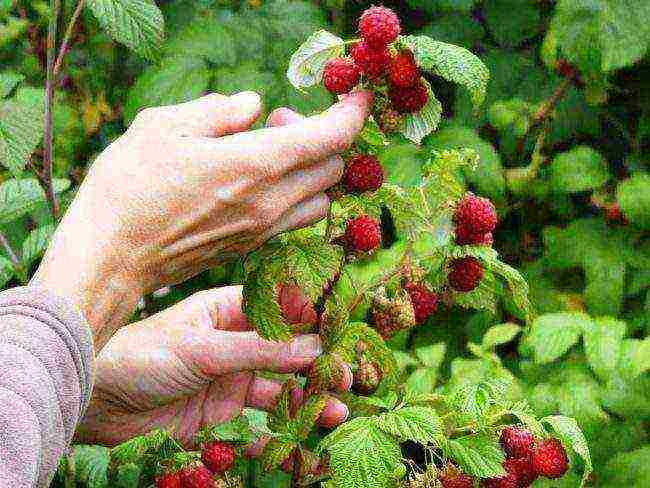
The "Penguin" remontant raspberry belongs to the early maturing varieties with a short period of fruiting.
Gardeners most often grow this variety in a one-year cycle, so it is very rare to see two-year shoots.... "Penguin" is a remontant variety. Its fruiting period is from late June to August. However, there are frequent cases of the first harvest of early ripe berries in late spring and early summer.
Reproduction
As for reproduction, gardeners resort to cuttings due to the small number of formed shoots. When planting, it is enough to keep a distance of up to half a meter between the bushes, since the raspberry of this variety grows slowly and compactly. Landscape designers often use this type of shrub when creating garden compositions. The dense dark green crown of the plant looks very impressive in combination with large raspberry fruits.
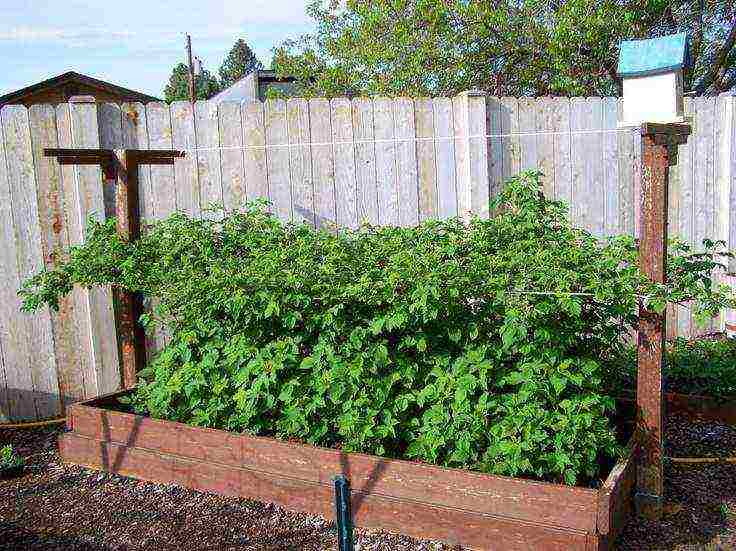
Compact bushes of the "Penguin" variety look very neat and are often used as a garden decoration.
Winter hardiness and susceptibility to disease
Winter hardiness and susceptibility to diseases in the variety are average.
- But also the ability to maintain shape during long-term transportation.
- The yield of raspberries Penguin is quite high.
- Double harvest and high productivity make this variety very popular among gardeners in central Russia..
Advantages of the variety
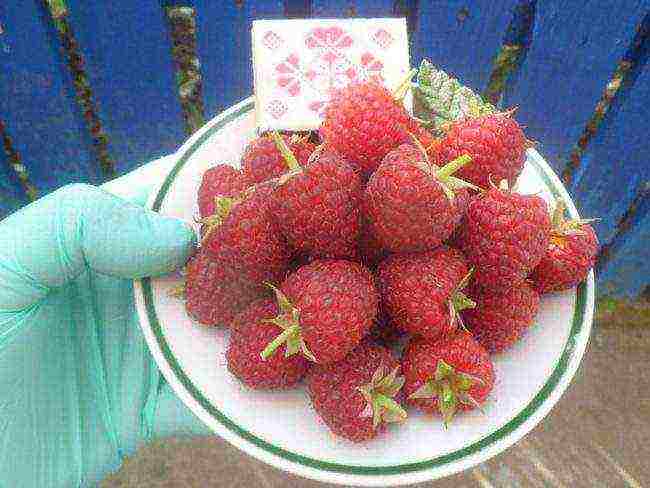
The raspberry variety in question is distinguished by rather large berries with dense pulp.
The Penguin variety has a lot of advantages, it is for this reason that it is so in demand among both amateurs and professionals. It is distinguished by:
- high productivity from one bush;
- aesthetic decorative appearance;
- low cost of planting material;
- simple care of the raspberry tree.
The low cost of seedlings, especially in comparison with European counterparts, makes the Penguin variety in demand in the conditions of modern economic realities. In addition, even amateur beginners can cope with planting and growing this type of raspberry, while the result will be guaranteed to be successful.
Flaws
The main disadvantage of the Penguin variety is winter hardiness.
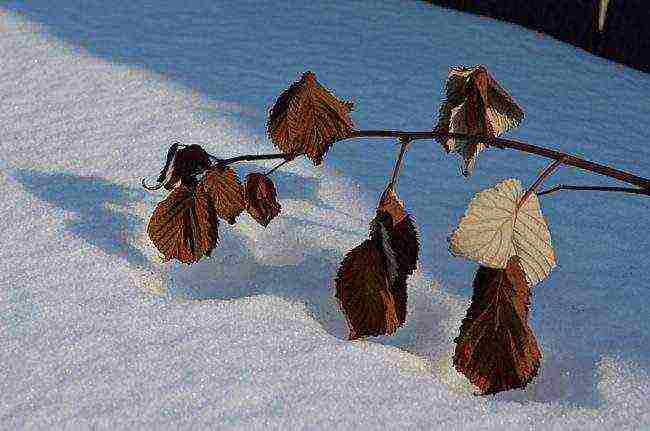
Shoots of raspberry "Penguin" above the snow cover, as a rule, freeze slightly.
The raspberry of this species is inaccessible for the northern cold regions, and the plant can endure low-snow winters only with complete pruning and mulching with agrofibre.
And also many people note mediocre tasting properties... But, as you know, this is a matter of taste. Excess acidity can be "removed" by proper planting in a sunny, windless place, controlled watering and application of fertilizers and top dressing.
In addition, in the blanks, the taste of berries is easily adjusted by the required amount of sugar.
Planting raspberries
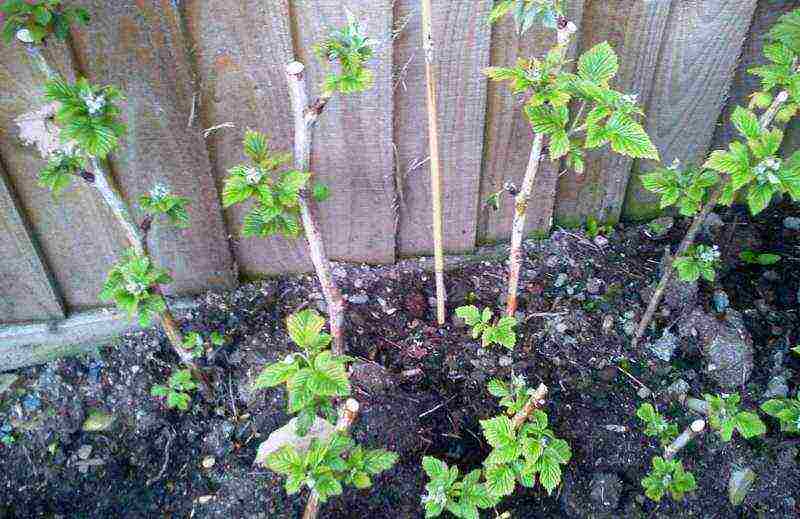
Penguin raspberry cuttings take root within a month.
As mentioned earlier, the Penguin cultivar is best propagated by cuttings.... Their circumcision takes place on a cloudy day. The length is chosen in the range of 10-15 cm. A small amount of leaves is encouraged.
- Next, you should send the cuttings to an aqueous solution with growth stimulants for about 6-10 hours.
- Then you can plant in pots. When the cuttings have completely taken root, it is worth transplanting them into a deeper container.
- Gradual adaptation to the external environment and constant monitoring of the resulting planting material will allow, after a while, to plant seedlings in open ground.
- Planting should be done in a place well warmed by the sun, but at the same time protected from wind and drafts.
- You should not plant raspberries in the place where the nightshade crops grow... The latter greatly deplete the soil.
In the first ten days of spring, it is necessary to dig small holes in the soil, about 40-50 cm deep.
In the case of a row planting, the distance between the rows should be at least 2 meters, with a cluster planting - 0.5–0.7 meters is enough. The soil removed from the pit is thoroughly mixed with top dressing and then half of the volume is placed on the bottom of the pit. The root system of the seedling is gently straightened and lowered into the hole, where it is then covered with the remaining soil. This is followed by abundant watering of 3 to 5 liters of water per bush. The top is mulched with hay, chopped straw or sawdust.
Autumn planting
It is worth starting to prepare for the autumn planting in the summer.... It is produced in last decade of September and early October... A pre-selected place is well dug up, cleared of weeds and enriched with fertilizers and top dressing. Most often it is manure, superphosphate and sulfuric potassium.
And yet, thinking about the time of planting seedlings, it is best to lean towards the spring time. During the summer, the raspberry bushes will get stronger, adapt and take root, which means they will have more chances to winter safely. Another "plus" of spring planting is the possibility of getting a double harvest per season.
Care
The yield of the bush primarily depends on the place of planting. Regular watering affects the formation of the ovary, so the issue of caring for the Penguin variety is of no small importance.
In fact, there is nothing difficult about it.Raspberry trees need to be weeded regularly, loosened and watered abundantly, especially in dry weather. Lack of sun affects the number of shoots formed. At a low growth rate of the bush, the shadow will further slow down the development of the raspberry tree.
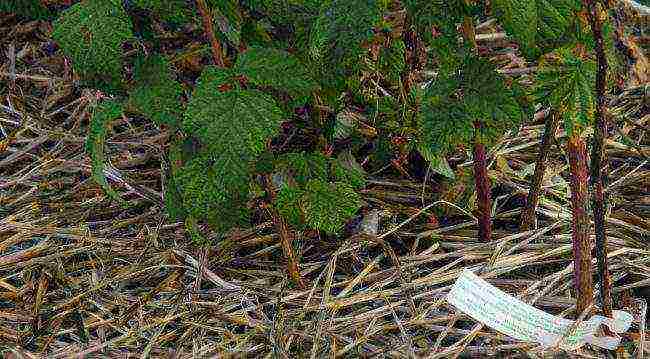
After loosening, it is recommended to cover the soil with organic mulching materials.
For any variety, the nitrogen content in the soil is important. Its deficiency is compensated by a large amount of various fertilizers (superphosphate and potassium salts) or urea.
Pruning
In the spring, damaged and frozen shoots are removed. The soil around the bush is actively mulched. Before that, last year's autumn mulch is removed. Pruning allows you to leave 10-15 shoots. This amount is enough to form a beautiful and slender bush.
Variety Penguin - a standard species that does not require tying... However, perfectionists may well use a low trellis up to 70 cm. When trimming the raspberry tree, it is worth leaving 3-4 fruitful shoots. This amount is sufficient to maintain yields.
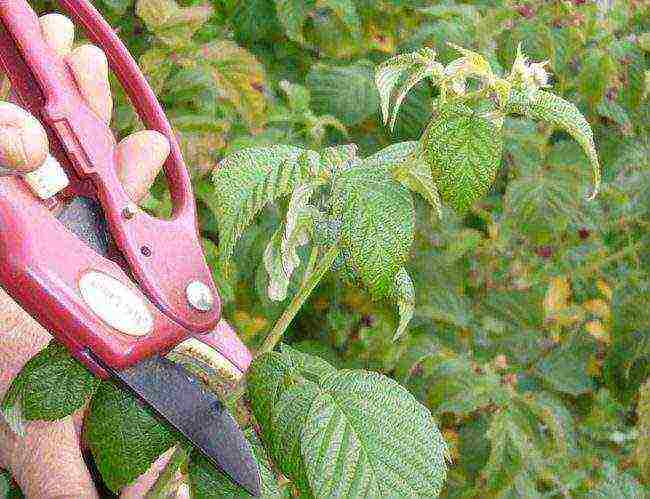
Spring pruning is done after the snow melts until the ground is completely warmed up.
Yield
The yield of the variety is characterized by gardeners as medium-high. From one bush, you can get from 2.5 to 5 kg of berries.
- Fruits are rich crimson matte cones weighing up to 4-5 grams... Good adhesion of the drupe allows the berries to attach well to the shoot, as well as resist direct sunlight. Unlike many other varieties, the Penguin does not bake in the sun.
- The fruits have a pronounced sweet and sour taste.... The sugar content depends on the growing soil and watering. The clayey soil enhances the acidity, and the heat and heat, on the contrary, make the berries sweeter and juicier.
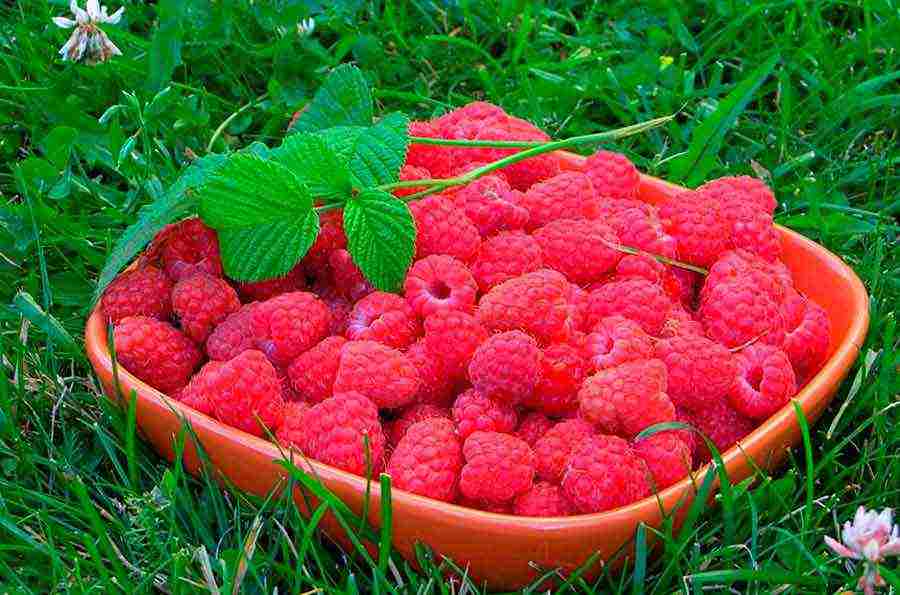
Already at the end of June, you can enjoy the first berries, and in August, harvest the second raspberry harvest.
Reviews of the Penguin variety
After breeding the variety, gardeners very quickly considered all the positive qualities of this remontant type of raspberry. An early harvest in early June will allow you to enjoy "living vitamins" at the very beginning of summer.
Among other things, many summer residents noted the ease of caring for the raspberry tree, as well as its aesthetics. A bountiful harvest with very modest time, physical and financial costs makes this variety very popular. No wonder the Penguin - many call it a variety for the lazy.
Video review of the "Penguin" variety of raspberries from an experienced gardener
